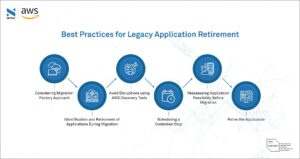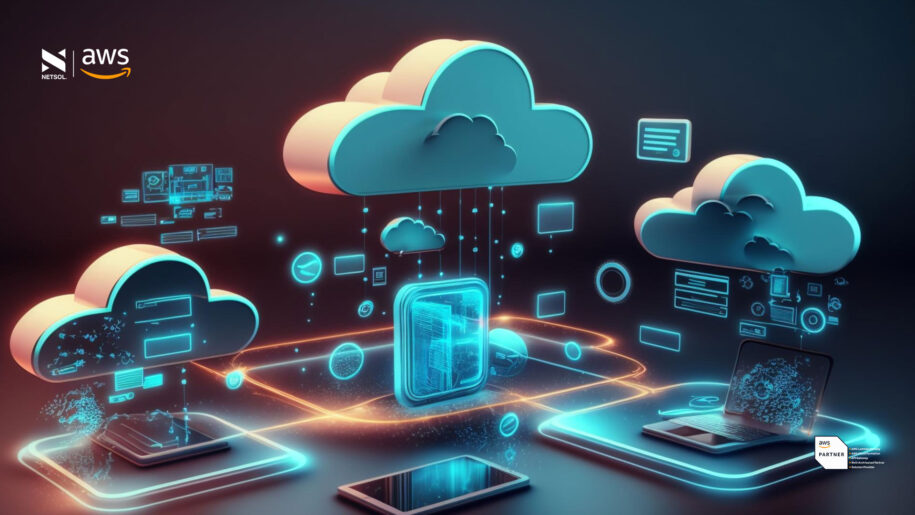Businesses are constantly looking for ways to improve their operations and scalability. In the ever-changing technology landscape, migrating applications to the cloud has become a crucial step toward achieving these goals. Today, Amazon Web Services (AWS) has emerged as a leader among cloud service providers, offering a robust platform that enables organizations to reach their full potential.
When migrating to AWS cloud, retiring old applications is essential. But retiring legacy applications shouldn’t have to be intimidating; it can open up a world of possibilities for businesses to embrace innovation. We are here at the last stop to discuss ways to retire a legacy system gracefully!
It will be the last part of the series, where we have discussed the best practices for application retirement in AWS cloud migration. Don’t worry; this blog will give you a comprehensive snapshot of the journey! Let’s get into it!
Series Part 6: Retire the Application Forever
As the world of technology continues to evolve at lightning speed, businesses must keep pace by embracing innovation. It requires letting go of outdated systems that no longer serve a purpose and are holding back progress. While legacy applications were once a point of pride, they can now be a liability that impedes growth and wastes valuable resources. That’s why it’s time to retire them for good and push forward with progress. By doing so, businesses can look forward to a brighter, more efficient future.
Best Practices for Legacy Application Retirement

Throughout this journey, we’ve explored five essential steps and best practices vital for businesses to stay competitive in today’s digital age. Now we all know that the world is moving at an incredible pace, where AWS cloud computing is becoming the new norm. Businesses are moving towards adaptive and evolving approaches. And hence, retiring legacy applications is now a strategic move, as it offers greater efficiency, scalability, and improved user experiences.
Retiring a legacy system is not just about getting rid of outdated software but about freeing your business from the constraints of old architectures, maintenance headaches, and security vulnerabilities. This newfound freedom of the AWS cloud environment opens up endless opportunities to adopt cloud-native solutions, embrace managed services, and unleash the full potential of modern technology.
That said, it’s time to retire the old and be in the now!
Hold on! If you haven’t had the chance to check out the previous parts of the series yet, then remedy this immediately. It is easier to understand the last part with them! In all things migration, we’ve got your back!
Considering Migration Factory Approach
The migration factory approach is a powerhouse of top-tier practices, tools, and procedures that can empower organizations to migrate to AWS cloud easily. This systematic and all-encompassing strategy ensures a streamlined and effective migration process while mitigating potential risks. With the AWS Migration Factory, organizations can enjoy a hassle-free and efficient shift to the AWS cloud environment.
The AWS migration factory approach involves discovery & planning, portfolio analysis, application profiling, validation & testing, and post-migration support. In the discovery & planning step, organizations can collect valuable information on applications, dependencies, and performance metrics. Portfolio analysis involves scrutinizing the applications and the workload before AWS cloud migration. In this phase, organizations can effectively prioritize migration efforts and allocate resources by sorting them into factors like business criticality, complexity, and risk.
In application profiling, organizations assess the compatibility of each application with the AWS cloud environment. They identify potential obstacles and decide whether to choose Lift and Shift, a re-platforming strategy, or opt for a complete application re-architecture. Businesses must conduct thorough validation and testing during migration to guarantee that the applications operate correctly in the AWS infrastructure. Finally, after transitioning from the old legacy infrastructure to the new AWS cloud environment, evaluate all the cutovers and reassess the migration process.
For more information, please read “Series Part 1: Considering Migration Factory Approach.”
Identification and Retirement of Applications During Migration
As organizations migrate to AWS cloud, it’s crucial to identify and retire applications that are no longer useful or aligned with their goals. This step ensures an efficient cloud environment and minimizes unnecessary costs. The process begins with a comprehensive assessment of the application portfolio, which provides insights into each application’s performance and resource utilization. Based on this information, organizations can decide which applications to retire and which can become part of the AWS cloud environment.
Here’s a tip! Once you have gathered enough information on all the applications you believe to migrate, start categorizing them! It’s crucial to take the time to organize your applications based on their importance, how frequently they’re used, and how well they align with your business objectives. Break them down into four primary categories – “Retire,” “Migrate,” “Re-host,” and “Re-platform” – you can simplify your cloud environment and ensure that you’re optimizing your resources. Don’t hesitate to retire any applications that are no longer useful or redundant to streamline your processes.
Check out “Series Part 2: Identification and Retirement of Applications During Migration” for a detailed read!
Avoid Disruptions using the AWS Discovery Tool
You read that right! There is a tool to help you out during this step!
In the world of business, consistency is critical to success, and interruptions can hinder progress. During AWS cloud migration, interruptions can significantly impact productivity, customer satisfaction, and revenue. Fortunately, AWS discovery tools exist to ensure seamless transitions.
Amazon Web Services offers some powerful discovery tools, including AWS Application Discovery Service (ADS) and AWS Migration Hub, to identify and evaluate on-premises applications. These tools provide valuable insights into application dependencies, performance, and resource usage. By utilizing these tools, businesses can understand their application landscape comprehensively, making it easier to decide which applications to retire or migrate.
Want to explore ADS and Migration Hub? You can explore your application portfolio with AWS Application Discovery Service (ADS) as a reliable guide. ADS reveals essential information regarding each application’s dependencies, performance metrics, and resource usage. This newfound knowledge provides a profound understanding of your entire AWS cloud environment.
On the other hand, AWS Migration Hub helps enterprises move applications and workloads smoothly. Migration Hub acts like a skilled conductor leading a symphony, ensuring your migration is organized, and applications are moved to their new cloud locations with minimal disturbance.
As migration progresses, agility and adaptability become increasingly important. When unexpected changes arise, AWS discovery tools are ready to reassess applications and adjust the path accordingly. They embody the spirit of innovation, steering you away from disruptions and towards the calm waters of the cloud.
For a detailed read, jump to, “Series Part 3: Avoid Disruptions using Discovery Tools.”
Scheduling A Controlled Stop
When migrating to AWS cloud, scheduling a controlled stop for your applications is essential. It means finding the perfect moment to temporarily halt operations and ensure a smooth transition to the new environment. The pause allows crucial tasks like data backup, synchronization, and user redirection to alternative solutions.
Meticulous planning and effective communication are essential to ensure a successfully controlled stop. Inform all stakeholders, including users, management, and IT teams, well in advance about the scheduled downtime to minimize disruptions and avoid chaos.
Additionally, perform a final data backup and securely archive any essential data. Redirect users to alternative applications or processes to avoid interruptions during the retirement phase.
If you need more insight into this? Read “Series Part 4: Scheduling A Controlled Stop” to know more.
Reassessing Application Feasibility Before Migration
Organizations must carefully assess and reassess each application before entering the world of AWS cloud computing. This process involves stepping back and reevaluating each application’s purpose, performance, and relevance with a fresh perspective. You never know when unforeseen business changes or new requirements might make a previously planned retirement no longer appropriate.
Compatibility with the AWS cloud environment is scrutinized, and the benefits of migration are weighed against potential challenges. This appraisal involves delving into the intricacies of the application’s architecture, dependencies, and integration points. It can also uncover opportunities to optimize applications and take full advantage of cloud-native services. During this phase, organizations prioritize applications based on their strategic value and complexity.
Stakeholders collaborate to ensure alignment with business goals and weigh the costs, risks, and potential rewards of migration against other options. Remember, stay flexible in your decision-making and adjust your retirement plans as necessary.
You need more information, right? Check out “Series Part 5: Reassessing Application Feasibility Before Migration” now!
Retire the Application
Here comes the final step! After you have evaluated and weighed all the options. The AWS migration factory approach is made; you have identified the applications that must be retired; with the help of AWS discovery tools you examined each app’s potential; the work of scheduling controlled stop is complete, and you have reassessed the application that has to be retired. So, what are you waiting for? Just retire the legacy application, say your final goodbye, and move on!
But here are a few things to complete in the meantime!
When retiring your legacy applications, managing access controls is essential. Make sure to revoke access permissions and credentials associated with those applications to prevent unauthorized access. Additionally, conduct regular audits to ensure the security of your AWS cloud environment.
Another thing is that retiring applications is a chance to reflect and gain valuable insights. To ensure this experience isn’t lost, documenting the reasons for retirement, steps taken, and lessons learned is vital. This knowledge transfer is an invaluable resource for future reference and training of new team members.
Witness Seamless AWS Cloud Migration without Disruptions
Retiring your applications from the AWS cloud environment is crucial in unlocking your organization’s full potential. With the help of AWS discovery tools, controlled stoppage scheduling, and application reassessment during migration, businesses can confidently retire legacy applications.
By embracing cloud-native alternatives and optimizing resource usage, you can streamline your AWS cloud migration and promote innovation. It’s essential to remember that application retirement is not the end; it’s a new beginning in the exciting world of AWS cloud computing. So, embrace the cloud, AWS, and embark on a transformative journey to reshape your business for the better.
For a reliable AWS cloud migration partner, feel free to contact NETSOL! Our team of experts is ready to help and assist you. It’s time to up your game and enter the realm of the cloud world with confidence.


Leave a Reply